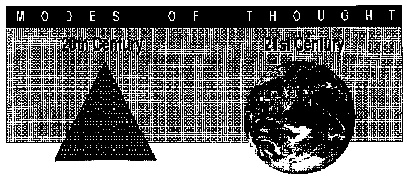PART I/No. 3 of 3: Acceptance Speech by
Dr. Takeshi Utsum
SLIDE 9: (Click here for large diagram)
This slide is an inverse pyramid, and the one for the space station library system we advocate.

SLIDE 10: (Click here for large diagram)
When we combine one triangle over the other, it becomes as shown on this slide. As you are very familiar, it is same as the Star of David, which is the symbol of Judeo-Christianity and Western culture based on justice, equality, and liberty.

SLIDE 11: (Click here for large diagram)
As the 21st Century is approaching closely, some people start advocating the modes of thought to be changed from the vertical pyramid in the 20th Century to a global (round) circle in the 21st Century -- refer to Rene Dubos' famous dictum "Think Globally." This diagram was taken from a flyer of COUNTDOWN 2001 in Alexander, VA. As we advocate a global neural computer network of global brain [Utsumi & Garzon, 1991], people and his/her knowledge database and their simulation model (which correspond to a neuron) will be webbed and symbiotically related each other via telecommunication media (which correspond to synapsis and nerves) for globally cooperative decision making in participatory democracy.

SLIDE 12: (Click here for large diagram)
This slide shows the circles of the globe and the geosynchronous orbit. As you may know, the circle is a symbol of Buddhism and Oriental culture, which are holistic and compassion.

SLIDE 13: (Click here for large diagram)
When all of those two triangles and two circles are combined together, as shown in this slide, it becomes a logo of our GLObal Systems Analysis and Simulation Association in the U.S.A. (GLOSAS/USA).

Here,
(a) The inner circle, globe and earth, is in light green, like the color of sprouting flora, signifying the source of oxygen -- without which no fauna can live. It also signifies the creativity of youngsters -- which is the driving force for betterment of human life. As we must protect flora in our environment, we must foster and cherish the creativity of youngsters.
(b) The vertical pyramid, conventional (analog) satellite system, is in scarlet, like the color of blood -- without which no living creature have life. It also signifies passion and feeling -- without which human life will not have beautiful poem, literature, painting, music, etc., and will be very dry society.
(c) The inverse pyramid, our advocating space station library system, is in royal purple which was used only by dynasty in ancient China. Our human's destiny must be royal and aristocratic, in a sense that it will give more than take.
(d) The outer circle, total of conventional satellite and space station library systems, is in deep blue of open sky, signifying intelligence and rationality.
The logo therefore represents space-age high technology and intercultural
philosophy and moral principle.
SLIDE 14: (Click here for large diagram)
The last slide was taken from FORTUNE, January 25, 1993, Page 69. It says "The great leaders of tomorrow will be the ones who understand how to get everyone to participate" -- in solving our pressing global problems together with the use of information and telecommunication technologies, for the betterment of our human society and for the sake of our future generations.

Our Global University is to bring youngsters forth for this leadership
to serve the world with the spirit of inverse pyramid.
VI. WHAT AHEAD
1. "Multimedia of America (MMOA)" (TM) Project
GLOSAS is now forging ahead to develop a one-to-many receive-only multimedia system to broadcast American educational courses to rural and remote areas around the world. Video of an instructor, handwriting in color on an electronic white board, image/graphic with annotation, dynamic graphic presentation by real-time execution of an application program/simulation model, etc., can be seen in windows on computer screen. On the other hand, teachers and professors (active or retired) can also transmit their courses from their offices or homes through ordinary telephone lines for worldwide broadcasting.
2. Large Scale GLH
In cooperation with the Fulbright Association Task Force on East Central
Europe and the Former Soviet Union, GLOSAS will assist Hungarian Fulbright
Commission to organize a large scale GLH at the occasions of the 50th anniversary
of Fulbright exchange program and of the 1100th anniversary of the nation
of Hungary. This GLH will be centered in Budapest, and will focus on medical
information, telemedicine, nurse training with electronic distance education,
etc. Proposed panelists are former President Jimmy Carter, former Surgeon
General Dr. Everett Koop, etc. This GLH will range from Japan, Australia,
New Zealand, North and South America, entire Europe and Former Soviet Union
(FSU).
VII. CONCLUSION
We all know that technological advances have made global communication an everyday fact of life: but the lives of so many millions of people, particularly in disadvantaged countries, are still untouched by the great educational possibilities that have already been opened up for relatively few [De Blasi, 1990]. We are at the threshold of a new age in education and communication but the use of the new tools is so far reserved mainly for the privileged few and is scarcely discussed as a matter of public policy. The emerging Global University (GU) attempts to provide cooperative, experiential learning opportunities on the widest possible scale and for the purpose of fostering peace and sustainable development [Ljutic and Utsumi, 1991].
Global University will distribute education from all the world's finest sources to all students who crave knowledge, wherever they are, so as to enlarge and expand the present exchange of courses into a worldwide educational system that can provide a specially tailored educational program for each individual, bringing to his or her home an array of resources that can empower individuals and bring new wealth to the Third World also.
Global (electronic) University is an evolutionary concept with no global precedent. The time is ripe for global electronic distance education. Let s work together.
Thank you very much for your listening.
REFERENCES
BUSINESS WEEK, January 17, 1994, Page 12 [BUSINESS WEEK, 1994]
De Blasi, M., Support letter for GLOSAS/USA's effort to de-regulate Japanese telecommunication policy, August 10, 1990. [De Blasi, 1990]
FORTUNE, May 18, 1992, Page 94 [FORTUNE, 1992]
Kouzes, James M., Behind Donald Regan's Downfall: Why Businessmen Fail in Government," The New York Times, March 8, 1987 [The New York Times, 1987]
Ljutic, A. and T. Utsumi, "Glasnost In The Global Village: A Glosas Project." Paper presented at the "GLASNOST AND THE GLOBAL VILLAGE" conference, York University, Toronto, Canada, February 19-22, 1991. [Ljutic and Utsumi, 1991]
Nippon Keizai Shimbun (Japan Economic Journal), August 2, 1989, in Japanese [Nippon Keizai Shimbun, 1989]
Utsumi, T., and A. Garzon, "Global (electronic) University for Global Peace Gaming," in Crookall, D., and Arai K. (eds) GLOBAL INTERDEPENDENCE: Simulation and Gaming Perspectives, Proceedings of the Conference of the 22nd Annual International Conference of the International Simulation and Gaming Association (ISAGA), Kyoto, Japan, Springer-Verlag, July 1991. [Utsumi & Garzon, 1991]
 Takeshi Utsumi, Ph.D.
Takeshi Utsumi, Ph.D.
Laureate of Lord Perry Award for Excellence in Distance Education
Founder, Consortium for the Affordable and Accessible Distance Education
(CAADE)
President, Global University in the U.S.A. (GU/USA)
Chairman, GLOSAS/USA
43-23 Colden Street, #9-L
Flushing, NY 11355-3998, U.S.A.
Tel: 718-939-0928
Fax: 718-939-0656 (day time only -- prefer email)
utsumi@columbia.edu
Back to
[ Top of this page | GLOSAS
home page | List
of Activities ]
Continue to PART II: VIDEO SHOW OF GLH ON JULY 7, 1994